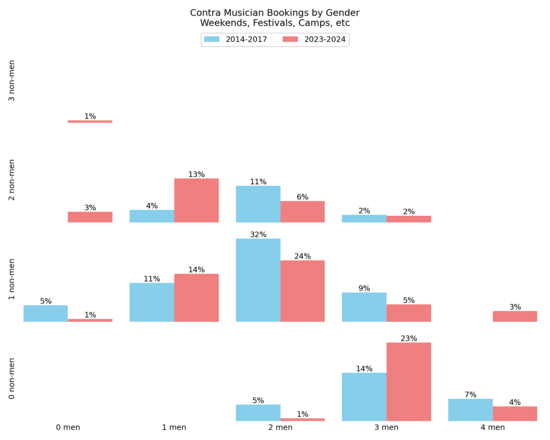Published on November 13, 2024 3:30 AM GMT
In the comments of yesterday's post on the most bookedcallers and bands, several people wereinterested in the gender composition of the bands. I looked atthis in 2018,covering four years of data (2014 through 2017); what does it looklike now?
I took my stats for 2023 and 2024 [1] andattempted to annotate the gender breakdown of the bands. This isa fraught endeavor: gender is not always obvious. In cases where itseemed unclear I looked at band websites, and when it was stillunclear I looked for publicity that referred to musicians withpronouns.
The biggest change from last time is the number of non-binarymusicians. I didn't count any as non-binary in 2014-2017 (which mighthave been a mistake), while for 2023-2024 I count 2% of musicians.And 10% of bookings contained at least one non-binary musician.
I'd like to plot something meaningful that I can compare across years,and it would be much clearer with two axes, so here's bookings by number ofmen vs number of non-men:
The total is essentially the same: 77% male in 2014-2017, 76% male2023-2024, but the distribution has shifted in interesting ways:
There are now more than zero duo and trio bookings with no men,and a noticeable increase in trios with one man. I had initiallyexpected to see that the overall balance had shifted away frommen (which it hasn't) and I think my impression was driven by seeingthese groups. The largest contributors here are Eloise&Co. and RiverRoad.
All the solo bookings with one non-man are Rushfest, but I'm not surethe decrease there is real: dance weekends are very inconsistent atlisting Rushfest gigs, and I've often missed them.
The increase in trio bookings with three men is primarily Playing withFyre, the Dam Beavers,and DriveTrain.
That these seem to be driven by individual bands suggests we shouldn'ttrust individual buckets too much. How sensitive is the overallratio, though? The totals are based on 1,032 booked individuals forthe smaller 2023-2024 set, so if one of the top bands (~15 bookingsover two years) had a female member replace a male one or vice versathat would bring the totals up to 79% or down two 73%.
If there are other ways of slicing this data that would be helpful inanswering this question, let me know!
[1] This means the same caveats apply: I'm not counting bands withoutnames, bands that played fewer than two weekends/festivals/etc in ayear, ways that the lineup at the gig might differ from what's on theband website, etc.
Comment via: facebook, mastodon
Discuss


